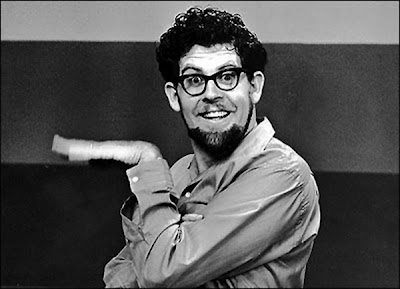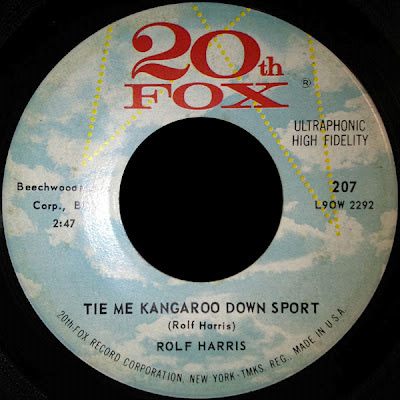Rolf Harris was born on 30 March 1930 in the Western Australia city of Perth, the son of Welsh immigrants, Crom and Agnes Harris. He relocated to England when he was 22 years old to work on a television show where viewers watched him draw the characters. He’s a fan of Aboriginal Australian music, incorporating instruments like the didgeridoo and wobble board into many of his songs.
This was a #1 hit in Australia that also went to #1 on the Billboard Adult Contemporary charts in America, but not in the same year. In fact, they weren’t even the same version. Rolf originally recorded this song in 1960. That’s the version that topped the Australian charts in May 1960 and went to #9 in England a couple months later. But that version was not heard much in America, even though it was released for distribution on 20th Fox. In 1962, Rolf got together with Beatles producer George Martin and did an updated version of the song. That’s the version that you remember hearing on the radio in America in the summer of 1963. It went to #3 on the Billboard Hot 100, #4 on Cashbox, #20 in Canada on 1050 CHUM in Toronto, and even managed to hit #19 on the R&B charts. This is also the version that finally broke through in Ireland, climbing to #9 there a couple months after becoming a smash novelty hit in North America. The 1962 recording, however, did not have an encore on the charts in Australia or England, and the song was completely overlooked in Germany and many other countries.
Here’s the original 1960 version of Tie Me Kangaroo Down Sport by Rolf Harris on 20th Fox 207:
Audio Player
And here’s the 1962 recording produced by George Martin that Americans remember hearing on the radio, released in the United States on Epic 9596:
Audio Player
Rolf Harris wrote this song in 1957, inspired by the calypso music of Harry Belafonte. In fact, the original working title of the song was Kangalypso. The song’s concept is very similar to a poem called The Dying Stockman written in 1885 by Howard Flowers and first recorded in 1905 by A. B. ‘Banjo’ Peterson. The song was first reworked at the EMI studios in Sydney in 1936 as a yodeling guitar tune by New Zealand-born Tex Morton as Wrap Me Up With My Stockwhip and Blanket on Regal Zonophone Records. These are the original lyrics of the ballad to read along with as you enjoy the Tex Morton recording:
A strapping young stockman lay dying
His saddle supporting his head
His two mates around him were crying
As he rose on his pillow and said
Chorus
Wrap me up with my stockwhip and blanket
And bury me deep down below
Where the dingoes and crows can’t molest me
In the shade where the coolibahs grow
Oh had I the flight of the bronzewing
Far over the plains would I fly
Straight to the land of my childhood
And there I would lay down and die
Then cut down a couple of saplings
Place one at my head and my toe
Carve on them cross stockwhip and saddle
To show there’s a stockman below
Hark there’s the wail of a dingo
Watchful and weird–I must go
For it tolls the death-knell of the stockman
From the gloom of the scrub down below
There’s tea in the battered old billy
Place the pannikins out in a row
And we’ll drink to the next merry meeting
In the place where all good fellows go
And oft in the shades of the twilight
When the soft winds are whispering low
And the darkening shadows are falling
Sometimes think of the stockman below
One part of Rolf’s original version of the song was considered racist by several critics, so Rolf removed the offensive words from later recordings and performances and apologized for them. That verse referenced the term ‘Abo’ which was an Australian slang term for Aboriginal Australians, that country’s version of Native Americans. It can be interpreted to mean that the dying stockman kept them as slaves, but it could also mean they worked for him voluntarily. Of course, you don’t let someone who works for you ‘go loose’ if they’re not held against their will.
Let me Abos go loose, Lew
Let me Abos go loose
They’re of no further use, Lew
So let me Abos go loose.
Here’s a bit of BeatleMania associated with this song:
After performing with the Beatles, Rolf Harris gave the wobble board to Ringo Starr who now owns the largest collection of them outside Australia.
I’ve got some more interesting tales about Rolf Harris which I’ll share with you in future posts. In the meantime, you can here all the hits of Rolf Harris (he had eight of them) on MusicMaster Oldies, along with a couple dozen other tracks.



Brilliant – I love Rolf Harris: the man is a complete legend here in the UK.
Sorry, but that is not the original 1960 version, which I remember well, having bought a wobble board that year, which unfortunately I no longer have. Many thousands were sold throughout Australia that year and in 1961.
In your recording Rolf clearly does not say "go loose Bruce"; in fact you mention "Lew", which was not the case with the real original, in which it was most definitely Bruce.
You have demonstrated your ignorance of Australian history, slang and mores with your suggestion that the aboriginal stockmen were held against their will, a risible assertion by an obvious ignoramus.
Have you ever heard of the expression "let go", Mr Knapp, when reference is made to terminating someone's employment?
See if you can work it out from there.
No worries, mate, but with all due respect, pig's arse, rack off! There's no need to get mad as a cut snake over this. I won't claim to be an expert on Australian history, slang, or mores, but that doesn't make me "ignorant" or an "obvious ignoramus." I personally dubbed the recording posted here from the 45 RPM record pictured here. The numbers indicate that this record was pressed in 1960. It's a different version from the later release that became a hit in the states. Therefore, I stand by what I've published here. If you read my disclaimer, you will see that I do not guarantee the accuracy or completeness of any information I provide. I do the best I can given the resources available to me. Perhaps there were two different versions from 1960, one released in Australia and the other released in the USA. The Aussie release was on Columbia 45-DO 4131 with a purple and gold label. However, I doubt that's the case, since this version is exactly the same as the one Rolf lip-synced to when he appeared on Brian Henderson's Bandstand on Aussie television in 1960. Perhaps there was an even earlier recording with different lyrics. If that does exist, I have never seen or heard it, and it was NOT the version released in 1960 on 20th Fox 207. As for my "ignorance" of Australian history, I did not claim that aboriginal stockmen were held against their will. I said that the lyrics "can be interpreted to mean" that. I wasn't attempting to pass judgement on the controversy. I was merely trying to highlight the portion of the song that generated controversy. Of course I've heard the expression "let go" used in that context. However, the expression "go loose" hardly suggests that the subject was originally free to leave. Instead, it conjures up images of animals being released from a cage. If you can point me in the direction of a recorded version of the song where the words "go loose Bruce" are heard, I'd be very grateful. Finally, if you still think my report is not bloody deadset fair dinkum you must also take issue with the good oil on Wikipedia. http://en.wikipedia.org/wiki/Rolf_Harris